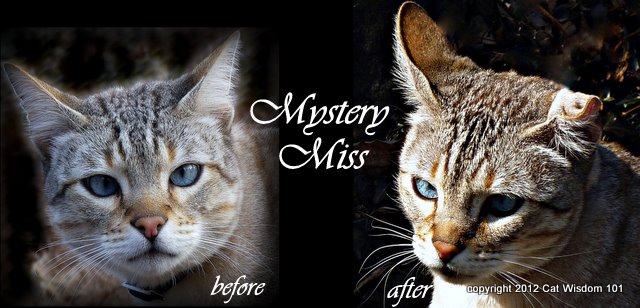Vet 101: Mystery Miss & the Case of the Cauliflower Ear
Vet 101 Q & A with Dr. Rich Goldstein will resume next week. This week he plays detective following the shocking discovery of Mystery Miss.
The Mystery of Mystery Miss and the Case of the Cauliflower Ear.
Odin hadn’t seen MM in over a week and ran straight up to her. Note their bushy tails. Normally bushy bottle brush tails can be aggressive or fearful posture if straight up or thrashing, but without any other agressive or defensive body language like flattened ears, but seemed more surprised to see each other. Within a few seconds they recognized each other and without other further adieu, raced around playing.
Dr. G. has this to say:
She appeared one day out of the blue, a vision of feline loveliness. Known only as Mystery Miss, she has been seen cavorting with local resident, Odin. Many questions have arisen: where did she come from, how did she arrive in the land of Odin? But now a new question has surfaced: what happened to her left ear?
Mystery Miss has refused to answer all questions posed to her – she maintains her right to feline privacy. But, as humans, it is our nature to speculate on answers to the unknown. So, let us ponder the mystery of Mystery Miss and the case of the cauliflower ear…
“Cauliflower ear” occurs when trauma to the external portion of the ear causes a blood clot (or hematoma) to form between the cartilage of the ear and its protective covering, called the perichondrium. As the damaged cartilage and perichondrium heal, scar tissue forms under the skin, resulting in a lumpy bumpy appearance that resembles cauliflower. Most notorious in boxers (the human kind), cauliflower ears are often seen in dogs (especially ones with floppy ears), and sometimes in cats.
So, what kinds of scenarios might have led to this blemish on Mystery Miss’ otherwise perfect furry form? The most common type of trauma that causes a hematoma to form in an ear flap (pinna) is self-induced. Scratching the ears and shaking the head due to an ear infection, ear mites, or an itchy allergy, can cause a blood vessel in the pinna to rupture, leading to a hematoma, and the subsequent cauliflower appearance. Other perpetrators can be implicated as well, however: a fight with a resulting bite or scratch to the ear can cause hematoma formation; bee stings or bug bites; frostbite; and tumors on the ear pinna can also lead to cartilage damage. And in some cats of the Scottish persuasion, the characteristic “fold” in the cartilage is the normal expression of a genetic trait, and not the result of trauma.
If caught early, ear hematomas can be surgically corrected to prevent or minimize the cauliflower appearance. Keeping the ears clean and ear mite-free is important in prevention of ear trauma, as is minimizing sun exposure in white and light-colored cats to help reduce the risk of cancers on the ears.
So…the question still remains, what happened to Mystery Miss? Only she knows for sure. But my theory? Judging by the way she makes eyes at Odin, I think that, just as Cupid was aiming his arrow, Mystery Miss turned her head to offer a wink, and her ear got nicked.
That’s my story, and I’m sticking to it.
The mystery continues…and the romance…
Have a question for Gr. G? Send it to layla@laylamorganwilde.com with vet 101 in the subject line.








18 Comments
Deb Barnes - Zee and Zoey
Layla – Our dog Bandit that you might recall from The Chornicles of Zee and Zoey also had that affliction. He was terribly neurotic and it was caused by his self-induced habit of constantly scratching at his ear… It was not hurting him and it happened later on in his life when it was nearing towards his end… If he were younger, we would have gotten him surgery to have the ear drained so that it would not have cauliflowered, but as it was not hurting him, the vet did not feel the procedure was justifed for him…
boomermuse
Sometimes even draining won’t prevent it. It was heartbreaking to see her beautiful head disfigured. I’d love to know what really happened.
Deb Barnes - Zee and Zoey
Yes… she is such a beauty. I hope she will be okay.
boomermuse
Deb, I’ll continue the hunt for her owners.
CATachresis
I will be very interested to see how the MM story pans out! Certainly she is a mystery!
Cheysuli
I think they are perfect for each other. Now if only Mystery Miss would give in and love Odin as he loves her…
Abby
AWWWWW MM it breaks our hearts that your ear wasn’t cared for medically.
purrs
>^,,^<
♥Abby♥Boo♥Ping♥Jinx♥Grace♥
Kathy Thompson
Poor MM.Maybe there will come a time when you can help her “lose” her collar. She is so beautiful it is sad to think that someone may not be taking proper care of her. HMMMMMMMMMMM Maybe Odin could persuade her to become one of the family! We hope all goes well! Luvs and purrs Skeeter and Izzy >^..*< MM's poor little ear!
boomermuse
Kathy, you’re reading my mind 😉
Caroline
Sorry to see this. I’d be happy to donate for her treatment.
boomermuse
Caroline, that’s very generous of you. Thank-you. She may have already been treated. The next step is continuing my search for her owners and to diplomatically deal with her tight/non-breakaway collar without ID with being the neighborhood busybody.
Tinch
MM, we still love ya!
Brian
Well Mystery Miss is gorgeous the way she is!
Nadbugs
Cupid missed? I don’t think so! Spot on!
Pam Kimmell
Interesting about the ear injury…doesn’t seem to bother Odin and his MM though! One good eye + one good ear still = LOVE!
Pam and Sam
Kathryn
Perfect. 1 plus 1 makes 2. 1 ear and 1 eye make 2 great loves.
I just love MM and Odin together.
Karen Jo
Thank you for all the information on cauliflower ear in cats. I didn’t even know that cats got cauliflower ears. I hope that the romance between Odin and Mystery Miss continues.
boomermuse
If only MM had earlier treatment perhaps this could have been avoided. The search is on for her owners.